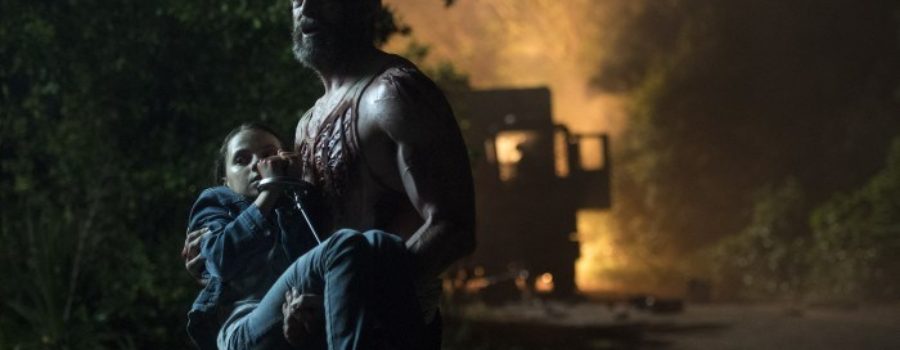 [Published at Awards Circuit] 2017 Berlin International Film Festival: A visceral, violent, sensitive and heartbreaking film, “Logan” overwhelmingly exceeds the hype. James Mangold‘s second entry into the standalone “Wolverine” franchise marks Hugh Jackman‘s last time dawning the now-iconic adamantium claws. The tone of “Logan” is set immediately, with the film’s setting portrayed as a barren, post-apocalyptic wasteland in the year 2029. Garrett James Hardin’s (an American environmentalist and philosopher) theory of the “Tragedy of the Commons,” wherein individuals consume what they please without a care for the common good until the world is depleted of most of its natural resources, has become a reality. This is where our world is headed, undoubtedly, and the fact that a film of this genre is aware of that, instead of mind-numbing mass destruction, is refreshing.
[Published at Awards Circuit] 2017 Berlin International Film Festival: A visceral, violent, sensitive and heartbreaking film, “Logan” overwhelmingly exceeds the hype. James Mangold‘s second entry into the standalone “Wolverine” franchise marks Hugh Jackman‘s last time dawning the now-iconic adamantium claws. The tone of “Logan” is set immediately, with the film’s setting portrayed as a barren, post-apocalyptic wasteland in the year 2029. Garrett James Hardin’s (an American environmentalist and philosopher) theory of the “Tragedy of the Commons,” wherein individuals consume what they please without a care for the common good until the world is depleted of most of its natural resources, has become a reality. This is where our world is headed, undoubtedly, and the fact that a film of this genre is aware of that, instead of mind-numbing mass destruction, is refreshing.
We see a vulnerable, aging Logan, pleasing comic book fans, as we finally see the “Old Man Logan” storyline from the Marvel comics. James “Logan” Howlett does not live forever, he just ages significantly slower than other mutants. His powers are diminishing, and his ability to heal has slowed. He is psychologically and emotionally damaged from a life of torture, loss and senseless violence. His alcoholism fuels his diminishing mutant abilities. He is a reclusive human being filled with regret, as he has destroyed everything and everyone close to him by trying to be of help throughout his life; Logan takes the brunt of this responsibility and blames himself for his losses.
Logan never lived his life for himself. He only lived to serve others with power who used his capabilities for their own sinister agendas – until he met Professor X of course. Logan’s relationship with Professor X has evolved into a deeper father-son kinship. The two of them have a dysfunctional family in the beginning, tied together by Caliban (comedian and “The Office” creator Stephen Merchant in a mesmerizing, transformative performance), the character of which appeared briefly in “X-Men: Apocalypse,” acting as the liaison of their “household,” which is a shack aptly located on an abandoned oilfield.
What Mangold has essentially done, is stripped the X-Men franchise of its excesses, and taken the powers out of the mutants. Professor X (Patrick Stewart) is 90 years old, and his mind, his most valuable asset, is losing cognitive function. He frequently has seizures that damage his brain and worsen his Alzheimer’s. His seizures, given his telepathy, affect those around him, too. He too is haunted by his past, namely a catastrophic event that one of his seizures caused. Logan and Caliban are, more or less, his caretakers.
In this future, “superheroes” have no meaning or place anymore; their abilities are not seen as a threat, but more of a military opportunity to create soldiers. Mutants are widely considered to be extinct, so the military creates mutants genetically; no longer are they born naturally. The government, now an authoritarian regime, has wiped out the race. Mangold adds pressing social commentary about the ill effects of immigration reform, as these gifted humans are now considered fugitives for merely existing in this country. “The Statue of Liberty was a long time ago,” Logan says to Professor X during the film. This future is not a stretch, as, given the state of the United States today, 12 years from now, American society could be in even worse shape than it is in “Logan.” This is essential viewing, one not just for fans of the comics.
Enter Donald Pierce (Boyd Holbrook), who works for Dr. Zander Rice (Richard E. Grant), whose father worked on the original Weapon X program with William Stryker, one of the men who created the monster Wolverine and brainwashed him and bent him to his will. Pierce and Rice want X-23 (a result of a revived attempt at the Weapon X program from the 1980s) in order to manipulate and use her as a weapon. They also consider Professor X’s Alzheimer’s as a weapon of mass destruction, threatening their program. These villains, which really take a commendable backseat compared to the film’s larger themes, provide the incentive of consanguinity for the protagonists.
This movie administers a realism that has rarely been seen before in the superhero genre, and never so fully. There is no mass destruction, as that has already happened by overpopulation and the excesses of a distorted capitalist society. Humans in the city live in either excess or crime, ignoring the deterioration of their surrounding environment. Rice is essentially the head of homeland security, and he oppresses minorities and mutants alike, using poor Mexican women to carry the babies that were created using dead mutants’ DNA.
Mutants have become folklore, with the only remnants of the past being sensationalized in the form of comics. This is a nod to classic source material, where we have glimpses of the hyperbolized events, most of which Logan claims never happened. Additionally, there is nothing left in this depressing, empty, dystopian hell to save. The only thing that is worth saving to these characters is friendship, love and compassion in a world that has forgotten those vital components that once characterized it. The few mutants left have to stick together and build a foundation of hope. “This is what family feels like,” Professor X says to Logan, still loyally trying to save him from his inner demons.
The much-anticipated introduction of Laura Kinney, or X-23, into not only Fox’s X-Men Universe, but the film industry itself, does not disappoint. Dafne Keen as the Wolverine clone is a revelation, utilizing her unique background in gymnastics and aerial arts to astonishing effects. This film will undoubtedly catapult her into stardom. She deftly balances savage aggression (her way of expressing sadness) and raw emotion with a deep longing for familial connection. She does not speak until 105 minutes into the film, and when she does, you finally see her humanity. At the film’s heart is Logan and Laura’s father-daughter bond; they save each other from impending doom. For Logan, X-23 gives his life meaning again, a chance for a do-over. For Laura, Logan’s advice and protection means saving her from a life of captivity, brainwashing and torture; he doesn’t want to see her go down the same path he did, which is, unfortunately, inevitable given their abilities.
“Logan” contains small and intimate moments, reveling in its dialogue and characters’ emotional bonding. This is something that has been sorely missed in prior superhero movies. It is part a road-trip, part western, part buddy movie, and part post-apocalyptic tale with sharp environmental and urgent social commentary. Mangold has created a film that is purely human in every sense of the word. Gone are the lavish CGI-laden special effects of the previous X-Men film installments. This is, by all means, a standalone film in the series; it is almost entirely its own movie.
Mangold cleverly incorporates the comics as both a meta-narrative, and a means of showing that it is the only written history of mutants. Jackman gives his best performance as Wolverine yet, pouring his heart and soul into the evolution of a character that he spent 17 years developing. Gone are the quick-witted, cheesy dialogue that the character of Wolverine possessed in Bryan Singer’s previous installments. It is replaced by anger, bitter cursing, and an egoless self-depreciation. Jackman, along with Keene, deserve Oscar nominations for their gritty performances.
There is cursing. There is brutal violence, as there should be, given the nature of Logan and Laura’s abilities. We finally see the full scale of Wolverine’s bestiality, and Laura’s, for that matter. There is also a gigantic, bloody heart in this film’s existential story. Yes, there is action, as there has to be to some extent in a “comic book” film, but in no way, shape, or form is this action campy or superfluous. The R rating works on so many levels and allows for a more mature story that is not meant to cater to everyone. Its rating eliminates the limitations that a PG-13 rating establishes from making a film like this work. Mangold said this of the creative freedom the R rating allowed him: “I didn’t want to make a more violent, sexier, more explicit, more obscene movie, I wanted to make an adult movie. This is not a movie for 9-year-old children. When your movie is rated R, you suddenly are making a movie about more grown-up themes. You’re not under the pressure to make a movie for everybody.” Most importantly, the R rating allows Mangold to further confront the inevitability of mortality as well as the fragility of family.
The action is beautifully shot, even breathtaking, but not overwhelming; the violence and carnage is cathartic. Seeing Old Man Logan fight one last time with his feisty young counterpart provides for some of the most rewarding action sequences seen onscreen in recent memory. We finally see the blood on both of the central characters’ claws, which adds to the realism. In previous installments, there was no blood, as Wolverine used to tear through villains, coming out seemingly spotless. There are two major set pieces. They are large but not showy, with most of the set design constructed at the NASA Michoud Assembly Facility in New Orleans (the oilfield and the Oklahoma City casino hotel), where the film was shot primarily along with New Mexico so as to capture the desert setting.
The title, “Logan,” serves as a means to highlight the character’s humanity. We are seeing the person, Logan, not the animal, Wolverine, even when he reluctantly fights. The script, written by Michael Green, Scott Frank and James Mangold, has finally lifted the facade of Wolverine’s pompous persona, and Mangold provides an unfiltered lens into the soul of Logan. The tone is undoubtedly bleak and somber, and comedic relief is rare, which is an abundantly welcome change compared to other entires in the superhero genre. Even Christopher Nolan’s “The Dark Knight” trilogy, lauded for its realistic portrayal of the tired genre, had cheesy, unrealistic dialogue. What replaces the comedy in “Logan” are heartwarming, emotionally sonorous scenes of human interaction. It is a soulful film, with a wonderful piano score.
This is the furthest thing from a superhero film, by any standards. It has evolved the comic book genre to new heights within the medium of film, elevating it to among the best of science fiction films that interweave unnatural scientific prognostication, such as cloning, to show the potentially dark, dystopian future these issues could create. It contemplates the morality of scientific advancement and adroitly blurs the line between between fiction and reality. Logan is a reluctant guardian of young Laura, but eventually develops a cellular bond with her. He is not the hero of this story, but rather just a man who finally opens up to love and its intrinsically healing nature. The final song, “The Man Comes Around,” as the credits roll, perfectly sums up Logan’s character arc throughout his record-setting 10 turns as Wolverine. At long last, we see the multidimensional character that Logan always was in the comics portrayed onscreen. Viewers who are sentimental should not forget to bring tissues to the theater, because the performances of Stewart (his best turn yet as Professor X), Jackman and Keen will absolutely resonate with them. Do not miss the shocking and euphoric climax. As Jackman said, this is his love letter to the loyal fans of his indelible portrayal of the adamantium-plated mutant. It most certainly shows.
“Logan” is produced by Twentieth Century Fox. It debuted at the Berlinale on Feb. 17, and will be released worldwide on March 3.
GRADE: (★★★★)








Leave a Reply
Your email is safe with us.